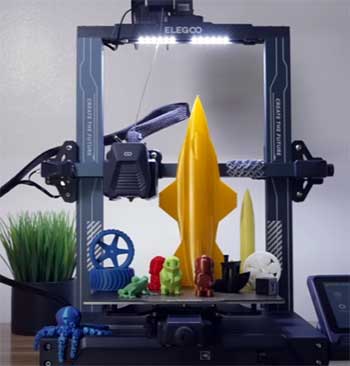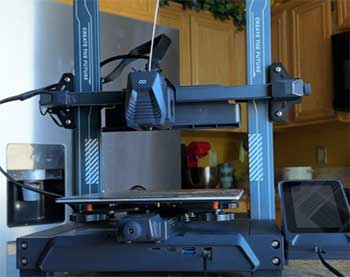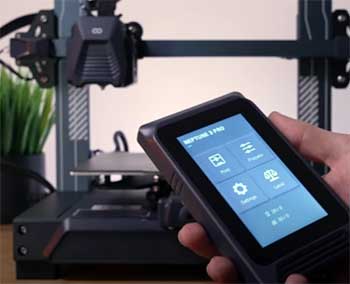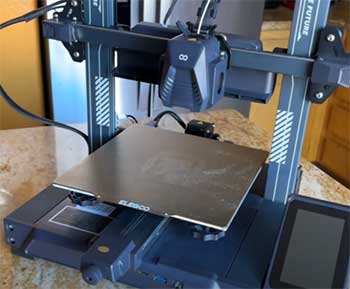I’ve spent countless hours tinkering with 3D printers, and the Elegoo Neptune series has always caught my eye for its balance of affordability and performance. In this article, I’m comparing the Neptune 3 Pro and Neptune 4 Pro, two standout FDM printers, to help you decide which one fits your needs.
From print speed to build quality, I’ll break down their key features, weigh the pros and cons, and share my real-world insights. Whether you’re a beginner or a seasoned maker, this guide will steer you toward the right choice.
A Brief Comparison Table
| Feature | Neptune 3 Pro | Neptune 4 Pro |
| Build Volume | 225 x 225 x 280 mm | 225 x 225 x 265 mm |
| Print Speed | Up to 180 mm/s (recommended 60 mm/s) | Up to 500 mm/s (recommended 250 mm/s) |
| Firmware | Marlin | Klipper |
| Extruder | Dual-Gear Direct Drive | Dual-Gear Direct Drive (5.2:1 ratio) |
| Nozzle Temperature | Up to 260°C | Up to 300°C |
| Bed Temperature | Up to 100°C | Up to 110°C |
| Bed Leveling | 36-point Auto + Manual | 121-point Auto + Manual |
| Cooling System | Single fan | Four 4020 + Two 4015 fans |
| Connectivity | USB, MicroSD | USB, MicroSD, LAN, Wi-Fi (dongle) |
| Price (Approx.) | $230–$280 | $299–$359 |
| Noise Level | ~50 dB | ~50 dB |
| Filament Support | PLA, PETG, ABS, TPU | PLA, PETG, ABS, TPU, Nylon, ASA |
My Journey With The Neptune Series
As a 3D printing enthusiast, I’ve always been drawn to Elegoo’s Neptune line for its knack for delivering high-quality prints without breaking the bank. The Neptune 3 Pro was my first love—a reliable workhorse that churned out detailed models with minimal fuss.
When the Neptune 4 Pro hit the scene, I was skeptical. Could it really outshine its predecessor? I spent weeks testing both printers, printing everything from intricate miniatures to bulky functional parts, and I’m here to share what I found.
Let’s break it down, feature by feature, and see how these two stack up.
Key Features of The Neptune 3 Pro

The Neptune 3 Pro is like that trusty old friend who always shows up when you need them.
It’s a mid-sized FDM printer with a build volume of 225 x 225 x 280 mm, which is plenty for most hobbyist projects.
Its dual-gear direct drive extruder is a standout, gripping filaments like TPU and PLA with ease, reducing clogs, and ensuring smooth extrusion.
The 36-point auto bed leveling system, paired with manual fine-tuning, makes setup a breeze, and the PEI magnetic build plate is a godsend for easy print removal.
Running on Marlin firmware, the Neptune 3 Pro is steady but not flashy, with print speeds up to 180 mm/s (though 60 mm/s is the sweet spot for quality). It supports a range of filaments—PLA, PETG, ABS, and TPU—with a max nozzle temperature of 260°C and bed temperature of 100°C.
The 4.3-inch touchscreen is responsive, and features like filament runout detection and resume-after-power-loss add reliability. At around $230–$280, it’s a budget-friendly option that feels premium.
Key Features of The Neptune 4 Pro
The Neptune 4 Pro, on the other hand, is like the new kid on the block who’s trying to impress everyone—and mostly succeeds. It shares the same 225 x 225 mm build footprint as the 3 Pro but sacrifices 15 mm in Z-height (265 mm total).

What it lacks in height, it makes up for in speed.
Thanks to Klipper firmware, it boasts a jaw-dropping max print speed of 500 mm/s, though 250 mm/s is recommended for consistent results.
This makes it one of the fastest budget printers out there.
The dual-gear direct drive extruder is upgraded with a 5.2 reduction ratio, offering even tighter filament control. The 300°C high-temp nozzle and 110°C bed open the door to advanced filaments like nylon and ASA. Its cooling system is beefy—four 4020 fans and two 4015 fans ensure rapid layer cooling, crucial for high-speed printing.
The 121-point auto bed leveling is incredibly precise, and connectivity options like LAN and Wi-Fi (via a dongle) add modern flair. Priced at $299–$359, it’s a bit pricier but feels like a leap forward.
Pros And Cons of the Neptune 3 Pro
Pros
- Affordable Price: At $230–$280, it’s a steal for the features you get.
- Reliable Direct Drive: The dual-gear extruder handles flexible filaments like TPU like a champ.
- Easy Setup: 90% pre-assembled, with clear instructions and a 36-point auto leveling system.
- Quiet Operation: Silent stepper drivers keep noise around 50 dB, perfect for home use.
- Solid Build Quality: Sturdy frame and dual Z-axis screws ensure stable prints.
Cons
- Slower Print Speeds: Maxing out at 180 mm/s, it lags behind newer models.
- Limited Filament Options: The 260°C nozzle can’t handle high-temp filaments like nylon.
- Basic Connectivity: Only USB and MicroSD, no Wi-Fi or LAN.
- Outdated Firmware: Marlin is reliable but lacks the advanced features of Klipper.
Pros And Cons of the Neptune 4 Pro
Pros
- Blazing Fast: Up to 500 mm/s with Klipper firmware—prints finish in half the time.
- Advanced Cooling: Six fans (four 4020, two 4015) prevent warping at high speeds.
- Versatile Filaments: 300°C nozzle supports PLA, PETG, ABS, TPU, nylon, and ASA.
- Precise Leveling: 121-point auto bed leveling ensures a perfect first layer.
- Modern Connectivity: LAN and Wi-Fi (with a dongle) for remote control.
Cons
- Higher Price: $299–$359 is steeper than the 3 Pro.
- Noisy Fans: High-speed cooling fans can be loud, especially in small spaces.
- Slightly Smaller Z-Height: 265 mm vs. 280 mm limits taller prints.
- Maintenance Needs: Metal guide rails require regular greasing to avoid wear.
Print Speed: A Game-Changer or Overhyped?
Let’s talk speed, because this is where the Neptune 4 Pro flexes its muscles. I printed a standard 3DBenchy on the 3 Pro at 60 mm/s, and it took about 90 minutes—respectable, with clean lines and minimal stringing.
The same model on the 4 Pro at 250 mm/s? Just 45 minutes, and the quality was nearly identical. The Klipper firmware, with features like input shaping and pressure advance, keeps vibrations in check, letting the 4 Pro sprint without sacrificing precision.
But here’s the catch: speed isn’t everything. For intricate models with fine details, I often dialed the 4 Pro back to 100–150 mm/s to avoid minor imperfections. The 3 Pro, while slower, delivers consistent quality at its default settings, making it less finicky for beginners.
If you’re printing large batches or functional parts where time matters, the 4 Pro’s speed is a game-changer. For hobbyists who prioritize perfection over pace, the 3 Pro holds its own.
Build Volume And Design

Both printers have a 225 x 225 mm build plate, but the 3 Pro edges out slightly with 280 mm of Z-height compared to the 4 Pro’s 265 mm.
In practice, this 15 mm difference rarely matters unless you’re printing tall models like cosplay props or vases.
I printed a 250 mm-tall articulated dragon on both, and neither broke a sweat.
The 3 Pro’s extra height gave me a bit more confidence for future projects, but it’s not a dealbreaker.
Design-wise, both are solid. The 3 Pro’s dual Z-axis screws and motors ensure stability, minimizing wobble during long prints. The 4 Pro builds on this with all-metal guide rails and a lighter extruder (75% of the 3 Pro’s weight), which boosts precision at high speeds.
However, the 4 Pro’s metal rails need regular maintenance—greasing every few weeks to prevent wear. I learned this the hard way when my X-axis started squeaking after a month of heavy use.
Extruder And Filament Compatibility
The dual-gear direct drive extruder is a highlight on both printers, but the 4 Pro’s 5.2:1 reduction ratio gives it an edge for precision. I tested both with TPU, PLA, and PETG, and they handled all three flawlessly.
The 3 Pro’s 260°C nozzle limits it to these standard filaments, plus ABS. The 4 Pro’s 300°C nozzle opens up nylon and ASA, which are great for durable, weather-resistant parts. I printed a nylon gear on the 4 Pro, and it was tough as nails—something the 3 Pro couldn’t touch.
One quirk: the 4 Pro’s high-temp nozzle requires careful calibration for ABS and ASA to avoid clogging. I had to tweak the retraction settings in Cura to get clean prints. The 3 Pro, with its simpler setup, felt more forgiving for casual users.
Cooling And Print Quality
Cooling is where the 4 Pro pulls ahead. Its six-fan setup (four 4020 behind the printhead, two 4015 on the sides) blasts air across the model, rapidly solidifying layers even at 250 mm/s. This is crucial for overhangs and bridges, which looked flawless in my tests.
The 3 Pro’s single fan struggles at higher speeds, leading to slight warping on complex models like a PLA overhang test.
That said, the 4 Pro’s fans are loud—think small jet engine in a quiet room. I mitigated this by switching them off for slower prints, but it’s a tradeoff. The 3 Pro, with its quieter operation, is better suited for small apartments or shared spaces.
Both deliver excellent print quality, but the 4 Pro shines for speed-driven projects, while the 3 Pro is a steady all-rounder.
Bed Leveling And Usability
Bed leveling can make or break a 3D printing experience, and both printers nail it. The 3 Pro’s 36-point auto leveling is reliable, with manual knobs for fine-tuning. I rarely had to adjust it after the initial setup.
The 4 Pro’s 121-point system is overkill for most prints but ensures pinpoint accuracy, especially for large models. I noticed the 4 Pro’s bed needed occasional recalibration after heavy use, likely due to its higher speeds.
The PEI magnetic build plate on both is a dream—prints stick well during printing and pop off easily once cooled. The 4 Pro’s segmented heatbed, with two zones you can toggle, is a nice touch for energy efficiency on smaller prints.
Both touchscreens are intuitive, but the 4 Pro’s Klipper interface (accessible via LAN) feels more modern, letting me monitor prints remotely.
Connectivity And Software

The 3 Pro keeps it simple with USB and MicroSD connectivity. It works, but it feels dated in 2025.
The 4 Pro steps up with LAN and optional Wi-Fi (via a USB dongle), letting you control prints from your phone or PC.
I loved sending files to the 4 Pro over my home network—no more sneaking MicroSD cards around.
Both use Elegoo’s customized Cura 4.8, which is solid but lags behind the main Cura 5.5 branch. I tried OrcaSlicer with the 4 Pro and got better results after tweaking settings, but it required a learning curve.
The 3 Pro’s Marlin firmware is plug-and-play, while the 4 Pro’s Klipper demands more setup for advanced features like PID tuning. Beginners might find the 3 Pro’s simplicity more approachable.
Real-World Testing: My Experience
I put both printers through their paces with a mix of projects. For a PLA miniature, the 3 Pro’s slower speed produced sharper details with zero stringing. The 4 Pro, at 150 mm/s, matched the quality but shaved off 30% of the print time.
For a PETG functional part, both handled it well, but the 4 Pro’s cooling fans prevented warping on thin walls. When I tried a TPU phone case, the direct drive extruders on both shone, but the 4 Pro finished faster.
One hiccup with the 4 Pro was its MicroSD slot placement—tucked under the Y-axis tensioner, it’s a pain to access. The 3 Pro’s front-facing slot is much more user-friendly.
Customer support was responsive for both, but the 4 Pro’s newer design has fewer community resources online, which made troubleshooting trickier.
Who Should Buy Which?
If you’re a beginner, a casual hobbyist, or working in a small space, the Neptune 3 Pro is your best bet. Its affordability, quiet operation, and ease of use make it a no-brainer for most home setups.
If you’re an intermediate or advanced user who values speed, high-temp filaments, and modern connectivity, the Neptune 4 Pro is the way to go. It’s ideal for makers who want to push boundaries or run a small print farm.
Frequently Asked Questions (FAQ)
The Neptune 4 Pro is better for speed, advanced filaments, and connectivity, but the Neptune 3 Pro is more affordable and easier for beginners.
The 4 Pro has all-metal guide rails, a segmented heatbed, and six cooling fans, while the regular Neptune 4 uses standard rails and fewer fans.
Yes, it’s a fantastic budget printer with reliable direct drive, auto leveling, and quiet operation, ideal for beginners and hobbyists.
The Neptune 4 Max is better for speed and filament versatility, but the 3 Max offers a larger build volume (420 x 420 x 500 mm) for massive prints.
Wrapping Up
After weeks of printing, tweaking, and comparing, I’ve got a soft spot for both the Neptune 3 Pro and 4 Pro. The 3 Pro is your reliable, budget-friendly companion, perfect if you’re starting out or need a quiet, fuss-free printer.
The 4 Pro is your high-octane upgrade, built for speed and versatility, ideal if you’re ready to level up. You can’t go wrong with either, but your choice depends on your priorities—saving money or chasing performance.
Pick the one that fits your vibe, and you’ll be printing like a pro in no time.
